|
|
 |
New Products to Look For in the Coming Weeks
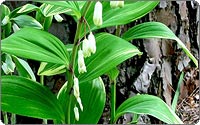
Solomon’s Seal—A History of Great Healing Value
Solomon's Seal has a rich history. Herbalists and healers, in Europe, North America and the Far East, have written about its diverse effects on numerous conditions for centuries. Solomon's Seal is named for King Solomon of the Hebrews. He was granted great wisdom by the Hebrew God and had a special seal that aided him in his magical workings, allowing him to command demons without coming to harm. According to herbal lore, King Solomon himself placed his seal upon this plant when he recognized its great value. Those with imagination can see the seal on the rootstock in the circular scars left by the stem after it dies back.
Solomon's Seal (polygonatum biflorum) that has diverse healing properties. It can be used as an herbal tincture (best use), salve, tea or supplement. As an alternative medicine, it gives relief, healing or mending to sports injuries and other acute injuries related to tendons, joints, ligaments, bones, bruises, connecting tissues, cartilage, osteoarthritis, etc. It also soothes and repairs gastrointestinal inflammation and injuries. It is effective for feminine issues, such as menstrual cramps, PMS, bleeding, and the like. Additionally, it is known to lower blood pressure, relieve dry coughs, and to increase concentration and mental clarity.
In his publication, Theatrum Botanicum, of 1640, John Parkinson, a renowned British apothecary, noted that Italian women used the root to improve their complexions and retain their beauty and agelessness. In North America, early native tribes made a tea of the rootstock as a cure for women's complaints and general internal pains. In some countries, Solomon's Seal is boiled and eaten as a vegetable similar to asparagus, and it has also been used in snuffs to induce sneezing and relieve head congestion.
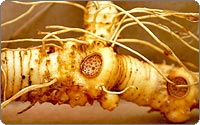 The fresh root, pounded and applied topically helps fade bruising. For centuries the powdered roots have been shown to make an excellent poultice for bruises, piles, inflammations and tumors. The bruised roots when mixed with cream were much used as a popular cure for black eyes. The bruised leaves made into a stiff ointment with lard served the same purpose. The fresh root, pounded and applied topically helps fade bruising. For centuries the powdered roots have been shown to make an excellent poultice for bruises, piles, inflammations and tumors. The bruised roots when mixed with cream were much used as a popular cure for black eyes. The bruised leaves made into a stiff ointment with lard served the same purpose.
Solomon's Seal is a bittersweet, astringent, tonic herb that includes convallarin (also one of the active constituents in Lily of the Valley), asparagin, allantoin, gum, sugar, mucilage, starch and pectin.
Chia Seed—The Ancient Seed of the Future
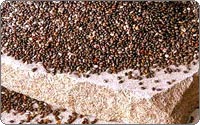 Chia is familiar to most of us as a seed used for the novelty of the Chia Pet™, clay animals with sprouted Chia seeds covering their bodies. Little is known, however, of the seed's tremendous nutritional value and medicinal properties. For centuries, the Indians of the southwest and Mexico used this tiny little seed as a staple food. Known as the running food, its use as a high-energy endurance food has been recorded as far back as the ancient Aztecs. It was said the Aztec warriors subsisted on the Chia seed during the conquests. The Indians of the southwest would eat as little as a teaspoon full when going on a 24hr. forced march. Indians running from the Colorado River to the California coast to trade turquoise for seashells would only bring the Chia seed for their nourishment. Chia is familiar to most of us as a seed used for the novelty of the Chia Pet™, clay animals with sprouted Chia seeds covering their bodies. Little is known, however, of the seed's tremendous nutritional value and medicinal properties. For centuries, the Indians of the southwest and Mexico used this tiny little seed as a staple food. Known as the running food, its use as a high-energy endurance food has been recorded as far back as the ancient Aztecs. It was said the Aztec warriors subsisted on the Chia seed during the conquests. The Indians of the southwest would eat as little as a teaspoon full when going on a 24hr. forced march. Indians running from the Colorado River to the California coast to trade turquoise for seashells would only bring the Chia seed for their nourishment.
Here are some of the fabulous properties of this super food.
Chia seed is a complete source of dietary protein providing all the essential amino acids. Compared to other seeds and grains, chia seed provides the highest source of protein: between 19 to 23 percent protein by weight, or 18 grams per 100 grams of seed. After ingestion Chia is digested and absorbed very easily. This results in rapid transport to the tissue and utilization by the cells. This efficient assimilation makes the Chia very effective when rapid development of tissue takes place, primarily during growth periods of children and adolescents.
- Ability to Absorb Water: One of the exceptional qualities of the Chia seed is its hydrophilic properties, having the ability to absorb more than 12 times its weight in water. Its ability to hold on to water offers the ability to prolong hydration. With Chia seeds, you retain fluids and electrolytes that provide the environment that supports the life of all the body’s cells.
- Supports Heart: Chia seeds can help reduce blood pressure. The seeds contain one of the highest known plant sources of essential fatty acids (omega-3 and omega-6). EFAs cannot be synthesized by our bodies however, it is very important that we get enough to support our immune, cardiovascular, nervous and reproductive systems.
It has approximately three to ten times the oil concentrations of most grains and one and a half to two times the protein concentrations of other grains.
- Stabilizes Blood Sugar: Chia seeds slow down the rate at which complex carbohydrates are digested and then assimilated into the body. The soluble fiber helps to stabilize blood glucose levels resulting in steady, sustained energy. In one study on diabetic patients, Dr. Vladamir Vuksan of St. Michael's Hospital in Toronto, found that blood was thinner and less prone to clotting and blood pressure of participants dropped significantly, after three months of taking Chia seeds daily.
- Food for Energy: The word “Chia” comes from the Mayan language and means strength. Chia seeds are a balanced blend of protein, carbohydrates, fats and fiber. It is said that 1 tablespoon of Chia can sustain a person for 24 hours. Athletes have reported that Chia seeds help them perform at optimal levels for much longer periods of time.
- Anti Inflammatory: The high concentration of omega-3 helps to lubricate joints and keep them supple. Additionally, Omega-3s are converted into prostaglandins which are known to have both pain relieving and anti-inflammatory effects.
- Super Powered Antioxidants: Chia seeds are an excellent source of antioxidants containing even more antioxidants than fresh blueberries. The high amounts of antioxidants in Chia seeds also keeps the oils from going rancid - contributing to a long shelf life.
Chia Seed Is Rich In Antioxidant Oils: Chia contains chlorogenic acid, and caffeic acid as well as myricetin, quercetin, and kaempferol flavonols. These compounds are both primary and synergistic antioxidants that contribute to the strong antioxidant activity of chia.
- A Rich Source of Calcium: Chia seeds contain the important mineral boron, which acts as a catalyst for the absorption and utilization of the calcium by the body. It is high in calcium and contains 5 times the calcium of milk, 631 mg per 100 grams of seed.
In Praise of Lavender—A Short History
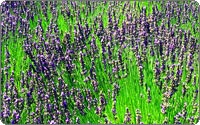 As an herb Lavender has been in documented use for over 2,500 years. In ancient times lavender was used for mummification and perfume by the Egyptians, Phoenicians, and peoples of Arabia. Romans used lavender oils for bathing, cooking, and scenting the air, and they most likely gave it the Latin root from which we derive the modern name (either lavare--to wash, or livendula--livid or bluish). The flower's soothing "tonic" qualities, the insect-repellent effects of the strong scent, and the use of the dried plant in smoking mixtures also added to the value of the herb in ancient times. As an herb Lavender has been in documented use for over 2,500 years. In ancient times lavender was used for mummification and perfume by the Egyptians, Phoenicians, and peoples of Arabia. Romans used lavender oils for bathing, cooking, and scenting the air, and they most likely gave it the Latin root from which we derive the modern name (either lavare--to wash, or livendula--livid or bluish). The flower's soothing "tonic" qualities, the insect-repellent effects of the strong scent, and the use of the dried plant in smoking mixtures also added to the value of the herb in ancient times.
Lavender is mentioned often in the Bible (John 12.3), not by the name lavender but rather by the name used at that time--spikenard (from the Greek name for lavender, naardus). In the gospel of Luke the writer reports: "Then took Mary a pound of ointment of spikenard, very costly, and anointed the feet of Jesus, and wiped his feet with her hair; and the house was filled with the odor of the ointment." Another ancient Christian reference to lavender involves how it got its scent. The plant is believed to have been taken from the Garden of Eden by Adam and Eve. However, the powerful perfume came later. According to legend, the clothing of baby Jesus bestowed the scent when Mother Mary laid them upon a bush to dry. This may explain why the plant was also regarded as a holy safeguard against evil. In many Christian houses, a cross of lavender was hung over the door for protection.
Perhaps first domesticated by the Arabians, lavender spread across Europe from Greece. Around 600 BC, lavender may have come from the Greek Hyeres Islands into France and is now common in France, Spain, Italy and England. The 'English' lavender varieties were not locally developed in England but rather introduced in the 1600s, right around the time the first lavender plants were making their way to the Americas. In Medieval and Renaissance Europe, the washing women were known as "lavenders" and they used lavender to scent drawers and dried the laundry on lavender bushes. Also during this time, lavender was grown in so-called "infirmarian's gardens" in monasteries, along with many other medicinal herbs. According to the German nun Hildegard of Bingen, who lived from 1098-1179, lavender "water,"--a decoction of vodka, gin, or brandy mixed with lavender--is great for migraine headaches.
Its holy reputation may have increased during the Great Plague in London in the 17th century, when it was suggested that a bunch of lavender fastened to each wrist would protect the wearer against the deadly disease. Furthermore, grave-robbers were known to wash in Four Thieves Vinegar, which contained lavender, after doing their dirty work; they rarely contracted the disease. In 16th-century France, lavender was also used to resist infection. For example, glove-makers, who were licensed to perfume their wares with lavender, escaped cholera at that time.
European royal history is also filled with stories of lavender use. Charles VI of France demanded lavender-filled pillows wherever he went. Queen Elizabeth I of England required lavender conserve at the royal table. She also wanted fresh lavender flowers available every day of the year, a daunting task for a gardener if you consider the climate of England. Louis XIV also loved lavender and bathed in water scented with it. Queen Victoria used a lavender deodorant, and both Elizabeth I and II used products from the famous lavender company, Yardley and Co. of London.
Properties and Uses
- Lavender is an aromatic, tonic herb with a sweet scent. Lavender is used internally for indigestion, irritability, anxiety, exhaustion, tension headaches, migraine and bronchial complaints. It is used externally to treat most type of burns, including sunburn, rheumatism, muscular pains, neuralgia, cold sores, insect bites, head lice, halitosis, vaginal discharge and anal fissure. It has an analgesic effect on the skin, which helps with pain relief, but it is the antiseptic and stimulant properties which make it very effective for use on wounds and burns.
- English lavender (Lavandula angustifolia) and French lavender (Lavandula x intermedia) are two of the most popular varieties. The English variation is considered to be the sweeter of the two and is commonly used in oils and perfumes. French lavender yields an essential oil with higher levels of terpenes, which create a sharper overtone to the fragrance. French lavender in commonly used in therapeutic applications.
- Lavender oil, made by extracting the essential oil from the lavender plant through distillation, is a popular perfume as well as medicinal remedy. Lavender is a natural antiseptic and has anti-inflammatory properties. Use lavender oil for scrapes, cuts, bruises, blemishes, infections, insect bites, and aching muscles. The oil is also soothing on the tummy during menstrual cramping and can also be used on the temples and back of the neck for headache or migraine relief. Add lavender to your bath to soothe aching muscles and aid relaxation.
- Dried lavender is used for everything from floral arrangements to eye pillows to scented (anti-moth) sachets for closets and drawers. Due to the soothing properties of lavender, sleeping pillows and restful eye pillows are popular applications. Lavender pillows work well when feeling overwhelmed by stress or irritation. Lavender sleeping pillows will assist children and infants that are fussy, light sleepers and may also help individuals who are experiencing nightmares (always check for allergic response prior to using any scented herbs with children).
Lavender Lemonade
If you like the floral taste of lavender, then this herbal lemonade recipe is for you. Nothing brings in the summer better than the taste of lemons and lavender.
Ingredients:
- 2 1/2 cups water
- 1 1/2 cups sugar
- 1/4 cup lavender flowers, chopped
- 2 1/2 cups water
- 1 cup lemon juice
- Ice cubes
Preparation:
First, heat the first measures of water and sugar to a boil until the sugar dissolves. Add lavender and let the mixture cool to room temperature. Strain out the lavender. In a pitcher, add lavender infusion to second measure of water and lemon juice. Stir and add more sugar to taste. Chill and serve lemonade over ice.
Serves 6-8
|
 |
|
|
|
|
A Message from Mark
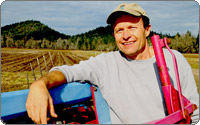
As I walk down the dusty road through the lush blooming fields to the mill I am amazed at the productivity of the land. Each year without fail the land delivers. We put in the seed, keep the weeds at bay, make sure we irrigate, and compost, and by this time of summer the fields are full of fine organic healing plants; from the pink of Echinacea and the purples of Lavender to the firm stately green of Ashwagandha. When I see the abundance it gives me a good feeling to know that we have been good stewards of the land. We are reaping its bounty and the good herbs we harvest are available to you. Stewardship is a word that is so important to what we do at Pacific Botanicals. It means having an awareness of how things connect to each other on the farm and how what we do here impacts the larger landscape.
In order to assure an abundant yearly harvest we need to not only take from the land but give something to it as well. We increase nutrient content by adding minerals and our naturally made compost, and by planting cover crops like oats, mustard, and red clover in fields that need rest and renewal. We try to match crops to soils so that each species is getting the best nutrient base possible. For example Angelica thrives best in a damp clay loam, and Astragalus in a sandy loam. We make sure that our topsoil does not wash away in the winter rainy season by using crops that hold the soil and prevent erosion.
We are very aware of the interconnectivity between what we do and the health of our local ecosystem. Since we are certified organic, no pollutants move from our farm into the watershed drainage. In short, we do everything possible to protect our watershed. In 2002 we were awarded the Water Shed Friendly steward award. We continue to abide by these principles. “Connectivity refers to the physical connection between tributaries and the river, between surface water and groundwater, and between wetlands and these water sources. Because the water moves downstream in a watershed, any activity that affects the water quality, quantity, or rate of movement at one location can change the characteristics of the watershed at locations downstream. For this reason, everyone living or working within a watershed needs to cooperate to ensure good watershed conditions.”—Oregon Wathershed Enhancement Board.
We have also been awarded the Salmon Safe certification that recognizes that our farming practices and conservation measures adhere to strict guidelines of sustainability for the indigenous salmon in our watershed. We also practice conservation of water resources by switching from flood irrigation to precise sprinkler irrigation.
The old English definition of “steward” means someone who watches out for the house. I guess I see our house as a beautiful giving piece of the green earth and that my job is to watch over this house and manage how we use it the best I can. I want to make sure that I am a good neighbor to all the species that we are interconnected with.
I hope that you know that each of the herbs grown here at Pacific Botanicals has this kind of care put into it and that we share something of our farm home with everyone who uses our herbs. This gives all of us who work at Pacific Botanicals a sense of joy.
I hope your families are having fun this summer and that you are well.
A Good Dog Gone
In Memoriam
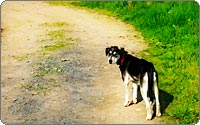 On August 6th, 2009, our very much loved farm dog, Bea the Wonder Dog, passed away. It was a sad day for all. Bea was a friend to everyone on the farm. Her mellow spirit was full of joy, sparkle and loyalty. She had a good life here on the farm. Whether she was tossing fresh caught gophers in the air, splashing playfully through the ditches, laying in the spring sun, trotting along the path with you from here to there, riding in the electric truck, or just sitting patiently waiting for some treats from one of her many admirers, she was a dear sweet dog who brought us all joy. On August 6th, 2009, our very much loved farm dog, Bea the Wonder Dog, passed away. It was a sad day for all. Bea was a friend to everyone on the farm. Her mellow spirit was full of joy, sparkle and loyalty. She had a good life here on the farm. Whether she was tossing fresh caught gophers in the air, splashing playfully through the ditches, laying in the spring sun, trotting along the path with you from here to there, riding in the electric truck, or just sitting patiently waiting for some treats from one of her many admirers, she was a dear sweet dog who brought us all joy.
I’m not sure where dogs go when they die but I am sure that a big part of Bea’s spirit will remain here on the farm. All of us will remember her love, friendship, and the pure joy she found in the simplest things. She will be missed.
~Mark Wheeler, Founder, Pacific Botanicals
|
|
|
|
|
|
Toni's Team Spirit
A Look Through My Window

I’ve shared this with a few of our customers when we’re on the phone together but I wanted the rest of you to have the opportunity to “look through my office window with me” at this very moment to see what I see here at the farm.
Currently there are two field crew members with large brimmed straw hats hand harvesting the special wormwood we are growing for one of our customers. The windows are open, I am enjoying the cool fresh morning air, and I can hear the crew quietly chatting to one another. They look peaceful and I’d guess they are loving their work as much as I love mine.
I see a frosty pink/purple swath of Echinacea in the big field that colors the background like living wall paper. There is a flutter of monarch and swallowtail butterfly stragglers that can’t seem to leave the farm to join the migration. I wouldn’t want to leave either. There are two bright blue lazuli buntings flitting about the pink flowers as well as a dozen or so bright yellow American gold finches zooming in and dining on the sunflowers my husband planted in the employee garden. And there are a bunch of honeybees buzzing around the bright yellow flowers of a late blooming mullein plant.
Welcome to my world. Each and every living thing on the farm contributes to the positive energy that supports our work. I am truly blessed to be here, blessed that Mark shares the wonders of this beautiful farm with a dozen of us year round—and shares his wonderful plant medicine with people around the world.
~
Blessings this summer,
Toni Evans
|
|
|
|
|
|
Into the Fennel Rows
by D.E.
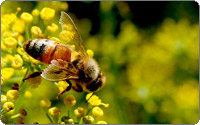 I knew I had to. It was undeniable. On my back were the worries of the day like a shirt too tight. It was hot and hard to move away from so much thinking but I had to. My soul required it. So I set out on the tractor path like a saint to supplication moving into the rippling fields. I felt assurance rising as my feet pounded the rocky path. I felt the sun on my arms in the surrounding heat like confidence and empathy all at once. Sky and wind were calling me onward through the great oaks set like arches on the path separating the world in my head from the living world at my feet…in front of my eyes. Pulling me out of my harried self. Down past the old swing and the woodpiles and the lavender rows releasing their healing fragrance like the intimate brushing of her dress. Dust swirled up from the firm step of my shoes like encouraging divas. Farther and farther down the old road like some battered hero of myth almost home I turned and went into the deep rows of golden-topped fennel as far as I could see. Down, down into the rows I went. The healing rows that smelled like licorice spice. Out into the center where I stood. Only bees and fennel and me. Mountains all around. I was amazed, thankful, close to tears. Hundreds of bees working all around me in precise abandon. Swirling and dipping and moving up and around the small yellow blooms. Wings glimmering in the sun as they did the dance to gather the sweetness. I was so close to them and I heard their sound. A language I remembered. The rising hum, like the secret vibration before a kiss, from the far off home I left eons ago. So I told them silently; I am an old friend. I have come home. I need a healing from the worries that have taken my head. With quiet generosity they gave their consent. I knew I had to. It was undeniable. On my back were the worries of the day like a shirt too tight. It was hot and hard to move away from so much thinking but I had to. My soul required it. So I set out on the tractor path like a saint to supplication moving into the rippling fields. I felt assurance rising as my feet pounded the rocky path. I felt the sun on my arms in the surrounding heat like confidence and empathy all at once. Sky and wind were calling me onward through the great oaks set like arches on the path separating the world in my head from the living world at my feet…in front of my eyes. Pulling me out of my harried self. Down past the old swing and the woodpiles and the lavender rows releasing their healing fragrance like the intimate brushing of her dress. Dust swirled up from the firm step of my shoes like encouraging divas. Farther and farther down the old road like some battered hero of myth almost home I turned and went into the deep rows of golden-topped fennel as far as I could see. Down, down into the rows I went. The healing rows that smelled like licorice spice. Out into the center where I stood. Only bees and fennel and me. Mountains all around. I was amazed, thankful, close to tears. Hundreds of bees working all around me in precise abandon. Swirling and dipping and moving up and around the small yellow blooms. Wings glimmering in the sun as they did the dance to gather the sweetness. I was so close to them and I heard their sound. A language I remembered. The rising hum, like the secret vibration before a kiss, from the far off home I left eons ago. So I told them silently; I am an old friend. I have come home. I need a healing from the worries that have taken my head. With quiet generosity they gave their consent.
~D.E.
|
|
|
|
|
|
Thoughts For the Spirit
Newsletter Quotes
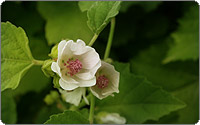 “We cannot cheat on DNA. We cannot get round photosynthesis. We cannot say, "I am not going to give a damn about phytoplankton." All these tiny mechanisms provide the pre-conditions of our planetary life. To say we do not care is to say in the most literal sense that "we choose death." “We cannot cheat on DNA. We cannot get round photosynthesis. We cannot say, "I am not going to give a damn about phytoplankton." All these tiny mechanisms provide the pre-conditions of our planetary life. To say we do not care is to say in the most literal sense that "we choose death."
~Barbara Ward
"The earth will not continue to offer its harvest, except with faithful stewardship. We cannot say we love the land and then take steps to destroy it for use by future generations."
~Pope John Paul II
"We have become, by the power of a glorious evolutionary accident called intelligence, the stewards of life's continuity on earth. We did not ask for this role, but we cannot abjure it. We may not be suited to it, but here we are."
~Stephen Jay Gould (The Flamingo's Smile: Reflections in Natural History)
"No settled family or community has ever called its home place an “environment.” None has ever called its feeling for its home place “biocentric” or “anthropocentric.” None has ever thought of its connection to its home place as “ecological,” deep or shallow. The concepts and insights of the ecologists are of great usefulness in our predicament, and we can hardly escape the need to speak of “ecology” and “ecosystems.” But the terms themselves are culturally sterile. They come from the juiceless, abstract intellectuality of the universities which was invented to disconnect, displace, and disembody the mind. The real names of the environment are the names of rivers and river valleys; creeks, ridges, and mountains; towns and cities; lakes, woodlands, lanes, roads, creatures, and people.
And the real name of our connection to this everywhere different and differently named earth is “work.” We are connected by work even to the places where we don’t work, for all places are connected; it is clear by now that we cannot exempt one place from our ruin of another. The name of our proper connection to the earth is “good work,” for good work involves much giving of honor. It honors the source of its materials; it honors the place where it is done; it honors the art by which it is done; it honors the thing that it makes and the user of the made thing. Good work is always modestly scaled, for it cannot ignore either the nature of individual places or the differences between places, and it always involves a sort of religious humility, for not everything is known. Good work can be defined only in particularity, for it must be defined a little differently for every one of the places and every one of the workers on the earth.
The name of our present society’s connection to the earth is “bad work” – work that is only generally and crudely defined, that enacts a dependence that is ill understood, that enacts no affection and gives no honor. Every one of us is to some extent guilty of this bad work. This guilt does not mean that we must indulge in a lot of breast-beating and confession; it means only that there is much good work to be done by every one of us and that we must begin to do it.”
~Wendell Berry, Conservation is Good Work, 1992
“There is no such thing as a self made man. We are made up of thousands of others. Everyone who has ever done a kind deed for us, or spoken one word of encouragement to us, has entered into the make-up of our character and of our thoughts, as well as our success.”
~George Matthew Adams, Philospher
"As soils are depleted, human health, vitality and intelligence go with them."
~Louis Bromfield
"We did not weave the web of life; we are merely a strand in it. Whatever we do to the web, we do to ourselves.”
~Chief Seattle, Chief of the Duwamish, Suquamish and allied Indian tribes (1786 - 1866)
“One can live at a low flame. Most people do. For some, life is an exercise in moderation (best china for special occasions), but given something like death, what does it matter if one looks foolish now and then, or tries too hard, or cares to deeply?”
~Diane Ackerman
What does a man need—really need? A few pounds of food each day, heat and shelter, six feet to lie down in, and some form of working activity that will lead a sense of accomplishment. That’s all in the material sense. And we know it. But we are brainwashed by our economic system until we end up in a tomb beneath a pyramid of time payments, mortgages, and preposterous gadgetry, playthings that divert our attention from the sheer idiocy of the charade.
~Sterling Hayden
The Old Eskimo hunters she had known in her childhood thought the riches of life were intelligence, fearlessness, and love. A man with these gifts was rich.
~Jean Craighead George
“Never eat more than you can lift.”
~Miss Piggy
|
|
|





